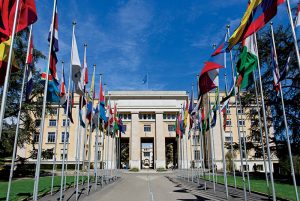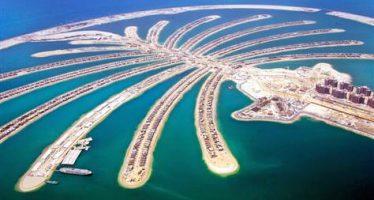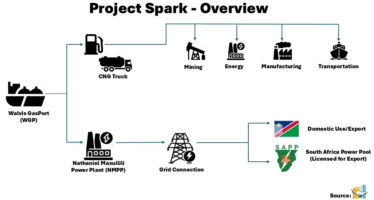UNCTAD: A Policy Compact to Get Investment Flowing Again

Geneva: United Nations
James Zhan suggests world leaders make a joint effort to formulate effective investment policies to help build investment firepower to face 21st Century development challenges.
Forecasts of deeper global economic gloom are tumbling one over the other. The global economy has been treading water for almost a decade now, and no manner of intervention since the start of the financial crisis seems to get us closer to turning the tide. The path to balanced, stable growth remains elusive, and while advanced economies have borne most of the brunt, more recently the woes have started spilling into emerging economies.
UNCTAD data show foreign investment zigzagging its way through the last nine years, with the best of the peaks still well below the height scaled in 2007. Unlike post-crisis trends in GDP growth and trade, international investment flows are still below pre-crisis levels. While preliminary data for 2015 show an upswing in foreign direct investment (FDI) flows, this was largely attributable to merger & acquisition activity, with greenfield investment in productive assets only contributing modestly to the growth. Some of the flows were also related to corporate reconfigurations involving large values in the financial account of the balance of payments but little movement in actual resources. In other words, the positive figures are a veneer which masks deep investor skepticism and lack of confidence in economic prospects. What is more, plummeting commodity prices are now biting deep into the investment flows to commodity-dependent countries, with the investment flows to Africa and Latin America faltering. And 2016 is marked for another decline by forecasters.
The Appetite Has Gone
A multitude of adverse factors has converged to unhitch the carriage from the growth locomotive. Steeped in debt, demand has slumped to chronically weak levels in high-income countries. At the same time a sharp deceleration is now evident in several large emerging markets, which has ushered the end of the commodity super-cycle. On the political front, pernicious inequality, regional conflict, security concerns and the migrant crisis have provoked further instability and uncertainty. The result: global economic and political gloom that has choked off FDI.
“UNCTAD data show foreign investment zigzagging its way through the last nine years, with the best of the peaks still well below the height scaled in 2007. Unlike post-crisis trends in GDP growth and trade, international investment flows are still below pre-crisis levels.”
This matters because investors operating across borders have become a significant force in the global economy. Just over 90,000 multinational enterprises (MNEs) have some $27 trillion of FDI stock invested in over 1 million foreign affiliates worldwide, UNCTAD statistics show. Together, these MNEs account for more than a quarter of global GDP and are behind one-third of private sector value-added. Their investments in productive assets overseas account for up to a third of capital formation in the productive sector in developing regions. Their global production networks drive as much as 80% of global trade, and they generate a sizeable share of formal employment in developing countries: foreign affiliates alone employ more than 80 million people, and that is without accounting for their impact on suppliers, contractors, service providers and other so-called non-equity forms of international production. And these affiliates contribute some $730 billion annually to government coffers in developing countries.
Bashful When They’re Needed Most
Investors’ reluctance to invest should deeply trouble policy makers. What is more, the international community last year announced the Sustainable Development Goals (SDGs) to advance global development objectives. The goals seek to arrest poverty, flatten out inequality, universalize basic services, preserve environmental integrity and ultimately create a safer, more prosperous world.
By UNCTAD’s count an average $3.9 trillion needs to be invested in SDG-related infrastructure development in developing countries if these highly ambitious development objectives are to be met. But current levels of investment in these sectors are at only a third of the required level, leaving an annual investment shortfall of some $2.5 trillion, outstripping the combined mettle of public investment, international aid and remittances. The crux is that private sector investment will be indispensable if the international community hopes to make a dent in poverty and the other global development challenges.
The incongruous present circumstances, however, set up a veritable conundrum: if delivery proves meaningful, the SDGs can be a tool to soften political tension and ease economic anemia; but economic and political conditions need to be more conducive to unlock more investment in the first place if the goals are to be achieved.
Clear and coherent policies will therefore be absolutely pivotal to overcome the blockage, unlock investment and funnel these flows to meet development objectives. In reality, however, investment policy suites around the world are not tailored for this purpose. Developments in investment policies in recent years have exposed an accelerating, clashing dichotomy: while the bulk of national investment policy measures implemented tends towards investment liberalization, facilitation and promotion, the overall share of restrictive measures has been on the rise (from an average of 5% in the early 2000s to an average of 27% in the past five years). What is more, a significant number of investment protection measures are hidden in the administrative processes applied at and behind borders.
Measures Do Not Match Investors’ Needs
On the investment promotion and facilitation side, UNCTAD analysis has also exposed structural weaknesses in the strategies governments most commonly choose to try lure investment to their shores. That is, instead of easing out and culling administrative and regulatory requirements in the operating environment to help investors get on with their business more easily, most governments opt to try coax them through incentives — and leave the obstacles unhindered for investors to muddle through.
A recent UNCTAD survey of FDI policies shows more than 1,100 new investment policies were set up over the past decade. Yet, for the 323 investment promotion and facilitation measures, the overwhelming majority was related to investment incentives or special economic zones-type benefits. Only 24% were measures that are truly facilitatory in nature.
This means a range of inexpensive, yet potentially valuable, policy fixes go unheeded: opaque legal or administrative requirements faced by investors, cumbersome operating environments, and costly business requirements. Rather than handing out incentives, fixing these constraints would be a far more compelling key to unlock investment flows in the first place, and create a business environment that would keep investors invested.
Interestingly, the same deficiency marks investment policies at the international level. In most of the existing 3,300 international investment agreements (IIAs) concrete investment promotion and facilitation actions are either absent or weak. UNCTAD analyzed 1,200 IIAs and found that only 22% of these treaties contain some sort of investment facilitation provisions. And even in those agreements that deal expressly with investment facilitation issues, many of the adopted measures are poorly designed and doomed to be ineffective. Far more work would need to be done to win over cautious investors.
Beyond the inability to effectively promote investment, the broader international investment policy regime also needs fixing. It is widely acknowledged that IIAs contain flaws that hold risks and uncertainty for signatory countries and benefiting investors alike. The IIA regime — with its almost 3,300 bilateral or regional treaties — as a whole is incoherent and fragmented, making it difficult and burdensome to implement and navigate. Another priority area for redress is the IIA regime’s compatibility with the development agenda. To an extent, investment treaties lock-in a country’s legislative environment for foreign investors. This puts the treaties at odds with evolving sustainable development objectives. Also under scrutiny is the regime’s dispute settlement mechanism, which exposes governments to costly legal action by aggrieved investors when they adjust their laws. What is more, the inefficacy of the investment mechanism has plunged it into a legitimacy crisis: arbitral findings, for instance, are sometimes inconsistent, which means divergent legal interpretations of similar provisions exit, undermining the predictability of the system. And no well-functioning appeals option is available. The investment policy diagnostic is unpropitious: the regime does not effectively serve the purposes for which it is intended and needs fixing.
A Policy Compact to Direct Them to Development
UNCTAD has long been advocating for more suitable and harmonized investment policies precisely to improve policy firepower to oil investment flows, particularly towards sustainable development objectives. The best way to achieve this would be for countries to formally join efforts and build a coherent set of national and international investment policies: something like a Global Investment Policy Compact, containing a set of guiding principles for investment policy making in the 21st century.
International coordination to global investment relations would be a stellar approach to stimulate investment for growth and jobs, to make investment contribute to sustainable development, to avoid protectionism, and to get investment policies to work in tandem with other policies such as those for competition, tax, trade, social and environmental policies, which can mean even more firepower to bolster the global economy.
Unfortunately, this is unlikely to happen because — unlike for international trade and finance respectively governed by the World Trade Organization and the International Monetary Fund — there is no global governance equivalent for international investment. This means the systemic problems that exist are addressed in a piecemeal way, mostly by individual country action in a kind of a trial-and-error approach, which is really the last thing one would want to see as a governance system for one of the central pillars holding up the global economy.
The governance vacuum has prompted UNCTAD to explore alternative ways to facilitate collective action. The organization has developed a diverse set of policy frameworks, with guiding principles and policy recommendations to address various aspects of investment issues. These policy instruments are intended to help prop up countries’ policy-making capacity and function like a toolbox, giving countries the policy options to address their particular national concerns and development prerogatives. The main components of UNCTAD’s comprehensive investment policy frameworks and capacity-building package are:
- The Roadmap for Reforming International Investment Treaty Regime was developed to guide the reform of the highly fragmented investment treaty regime and remedy commonly perceived problems and concerns. Elements include safeguarding the right to regulate, improving investment dispute settlement, promoting and facilitating investment, ensuring responsible investment, and enhancing systemic consistency.
- The UNCTAD’s Investment Policy Framework for Sustainable Development (IPFSD) is mainstay in UNCTAD’s advocacy to evolve a 21st century generation of investment policies. The framework accompanies the guiding principles and proposes concrete national and international policy options, aligned with sustainable development objectives. The framework has the potential to guide policy coherence and has already proven a strong impulse for international cooperation in the area of investment with the potential to prompt incremental multinational economic coordination in the long run. More than 105 countries are currently using it to reorient their policy suites.
- The Global Investment Facilitation Action Menu complements the IPFSD and comprises a set of policy options and actions to boost cross-border investment in productive assets, in parallel with and reinforcing analogous actions on trade facilitation, and remedying the systemic gap in international investment treaties, which insufficiently addresses actual investment promotion and facilitation measures.
- The Action Plan for Investing in SDGs is a comprehensive plan containing six sets of transformative policy actions aimed at governments, but also suggested measures for private sector action to promote and facilitate investment in low-income countries in line with the Post-2015 Development Agenda and its set of Sustainable Development Goals.
- The Entrepreneurship Policy Framework and implementation guidance supplements UNCTAD’s investment policy tools in support of the development of a strong, vibrant entrepreneurial sector to boost job creation and incomes. The framework consists of six policy components and forms the basis for a comprehensive, coordinated and inclusive approach to promoting entrepreneurship and the formulation and implementation of national entrepreneurship strategies and policies.
UNCTAD is also uniquely placed to facilitate consensus-building among countries through its intergovernmental convening power. This means while no formal multilateral negotiating mandate exists, an UNCTAD-facilitated investment policy conversation can give further impetus to comprehensively deal with the systemic policy concerns of the FDI regime in a manner approaching multilateral collaboration. Such an approach will reach much further than the fragmentary national and regional efforts that currently characterize investment policy making and reform.
UNCTAD’s World Investment Forum, which takes place in Nairobi, Kenya from 18-21 July 2016 will provide the next opportunity for exactly this kind of debate and key government leaders and investment stakeholders have already confirmed their participation in this dialogue. For the SDGs to gain traction, investment will be key. And for the right kind of investment to materialize, a common response to today’s shared ambition to promote investment in sustainable development is needed. The international community cannot afford to ignore the policy vacuum that characterizes the investment domain.
About the Author

James Zhan
James Zhan is Director of the Investment and Enterprise Division at the United Nations Conference on Trade and Development (UNCTAD). He leads the team that produces the World Investment Report.
You may have an interest in also reading…
Dubai’s Nakheel Says Back in the Black in H1
Nakheel, the Dubai developer that wrote down AED78.6bn ($21.4bn) from the value of its real estate as property prices in the
Project Spark: Powering Southern Africa’s Future Through a Balanced Energy Mix
Namibia’s first gas-to-power plant aims to address the region’s chronic energy shortages through a pragmatic, balanced approach that blends innovation,
Strategy&: Meeting the Big Data Challenge
Recent research on Big Data should sound an alarm bell for companies. On the one hand, there is a link



















































































